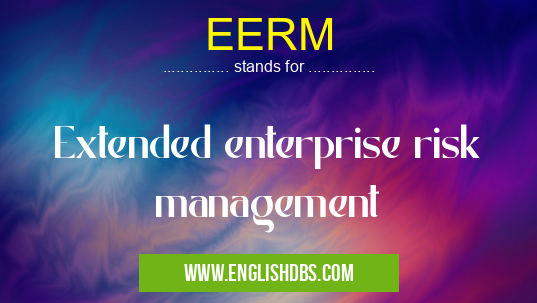What does EERM mean in MANAGEMENT
Extended enterprise risk management (EERM) is a comprehensive approach to identifying, evaluating, and mitigating risk in organizations that includes stakeholders from outside the traditional boundaries of the firm. It helps companies identify and manage the potential risks associated with their extended networks of partners, contractors, vendors, customers, and other entities. In this article we explore EERM in more detail and answer some frequently asked questions.

EERM meaning in Management in Business
EERM mostly used in an acronym Management in Category Business that means Extended enterprise risk management
Shorthand: EERM,
Full Form: Extended enterprise risk management
For more information of "Extended enterprise risk management", see the section below.
» Business » Management
Essential Questions and Answers on Extended enterprise risk management in "BUSINESS»MANAGEMENT"
What is Extended enterprise risk management?
Extended enterprise risk management (EERM) is a comprehensive approach to identifying, evaluating, and mitigating risk in organizations that includes stakeholders from outside the traditional boundaries of the firm.
Who are included in extended enterprise risk management?
EERM includes partners, contractors, vendors, customers, and other entities that interact with a business beyond its traditional boundaries.
How does an organization use EERM?
Organizations use EERM to identify and manage potential risks associated with these external entities. They may also look for opportunities for collaboration or ways to improve operational efficiency by engaging with these external stakeholders.
What type of risks does EERM help identify?
EERM can help organizations identify a variety of risks including reputational risks arising from negative public perception or customer dissatisfaction; market-related risks such as changes in economic trends; regulatory risks caused by new legislation or contractual requirements; financial losses arising from fraud or theft; operational disruptions due to natural disasters or labor strikes; and legal liabilities related to product liability or employment law issues.
What are the benefits of using EERM?
The main benefit of using an EERM framework is that it allows organizations to proactively identify potential risks before they become problems. This can help minimize losses from unforeseen events and increase customer satisfaction levels by mitigating supply chain disruptions or providing better service levels. Additionally, as more organizations look for ways to collaborate with external stakeholders for mutual benefit, EERM can provide a framework for assessing these opportunities while minimizing risk exposure.
Final Words:
In conclusion, extended enterprise risk management provides a comprehensive approach to managing threats arising from interacting with external stakeholders beyond organizational boundaries. By proactively identifying potential threats ahead of time it can help businesses minimize losses and increase customer satisfaction through collaboration opportunities while still protecting against unwanted surprises.
